2. 青海省盐湖地质与环境重点实验室, 西宁 810008;
3. 中国科学院大学, 北京 100049;
4. 山东省水土保持与环境保育重点实验室, 临沂大学资源环境学院, 山东临沂 276005;
5. 中国科学院青藏高原研究所大陆碰撞与高原隆升重点实验室, 北京 100101;
6. 安阳师范学院资源环境与旅游学院, 河南安阳 455000
2. Qinghai Province Key Laboratory of Geology and Environment of Salt Lakes, Xining 810008, China;
3. University of Chinese Academy of Sciences, Beijing 100049, China;
4. Shandong Provincial Key Laboratory of Water and Soil Conservation and Environmental Protection, School of Resources and Environment Sciences, Linyi University, Linyi Shandong 276005, China;
5. Key Laboratory of Continental Collision and Plateau Uplift & Institute of Tibetan Plateau Research, Chinese Academy of Sciences, Beijing 100101, China;
6. School of Resource Environment and Tourism, Anyang Normal University, Anyang Henan 455000, China
黄土中磁性矿物的形成、搬运、沉积以及后期改造都受到气候变化和环境过程的深刻影响,因此,黄土沉积物的磁学参数可以作为气候和环境变化的参考指标(刘东生, 1985; Kukla et al., 1988; Liu and Ding, 2003; Gao et al., 2018),其中磁化率测试便捷、快速,在古气候研究中最为常见,特别是Heller和Liu(1984)在黄土精确定年的基础上发现其与深海氧同位素具有很好的可比性之后,磁化率作为古降水量和东亚季风强度的可靠代用指标开始广泛应用于黄土高原地区的古气候研究中(An et al., 1991; Sun et al., 2011; Maher, 2016; Thomas et al., 2016; Peng et al., 2018).
前人利用黄土磁化率指示降水量变化主要基于对黄土高原地区磁化率变化机制的认识,即成壤作用形成的细粒磁铁矿、磁赤铁矿是磁化率增强的主要原因(Maher, 1988, 2016; Zhou et al., 1990; Liu et al., 2007).这种被称为“成壤说”的机制不仅适用于黄土高原地区,在东欧(Dodonov et al., 2006b; Constantin et al., 2014)、中亚(Ding et al., 2002; Dodonov et al., 2006a)以及伊朗北部(Ghafarpour et al., 2016)等黄土沉积区也同样适用.但“成壤说”并不能很好地解释高纬阿拉斯加和西伯利亚等地区的黄土磁化率变化,Begét(Begét and Hawkins, 1989; Begét et al., 1990)发现阿拉斯加地区黄土比古土壤磁化率高,认为该区磁化率可能受风速和源区距离影响,并通过风洞实验证明了上述猜想,即“风速论”模式;进一步研究发现,阿拉斯加和西伯利亚等高纬地区土壤水分充足,亚铁磁性矿物在还原环境下可被淋滤为硬磁性和顺磁性矿物从而导致古土壤层磁化率降低,即“还原性成壤”模式(Liu et al., 1999; 刘秀铭等, 2007a, b; Chen et al., 2016).上述研究表明,在不同地区、不同环境下的黄土磁化率变化机制可能存在差异.
新疆位于黄土高原、东欧以及西伯利亚等黄土岩石磁学研究较为深入的地区之间,其黄土主要分布于天山北部、伊犁盆地以及塔里木盆地南缘(图 1).新疆地区独特的地理位置和广泛堆积的黄土使该地区近年来逐渐受到关注,一系列黄土岩石磁学及磁化率变化机制研究也相继开展.例如,魏海涛等(2013)通过对天山北麓中梁剖面沉积物岩石磁学及粒度特征的分析,认为该地区黄土磁化率变化受控于粗颗粒磁性矿物组分,反映风尘搬运能力,符合“风速论”模式,东湾(DW)剖面、乌鲁木齐河(URS)剖面以及西昆仑钻孔的岩石磁学结果也均符合这一特征(Zan et al., 2010, 2012; Lu et al., 2016);然而,对于伊犁盆地西部的坎苏(KS)剖面和天山北麓的鹿角湾(LJW10)剖面,其磁化率变化机制则与黄土高原类似,遵循“成壤说”模式(Jia et al., 2011; Li et al., 2015c);Song等(2010)对伊犁盆地昭苏(ZSP)和塔勒德(TLD)剖面的岩石磁学特征进行了系统分析,发现源区输送的原生粗颗粒磁性矿物组分和成壤作用形成的次生细颗粒磁性矿物组分对研究区的磁化率变化均有影响,但以前者为主;对位于伊犁地区的则克台(ZKT)、阿西克(AXK)剖面和位于天山北麓的沙湾(SW)剖面的研究则表明,磁化率在不同沉积阶段表现出不同的变化机制,即“成壤说”和“风速论”两种模式在不同阶段各占优势(Jia et al., 2012; Li et al., 2015a).基于前人的研究工作不难发现:1)新疆地区的黄土岩石磁学研究目前还主要集中在天山北麓和伊犁地区(图 1),新疆南部、特别是塔里木盆地南缘地区厚层黄土的岩石磁学研究仍相对薄弱;2)天山北麓和伊犁地区的黄土磁化率变化机制存在时空差异.
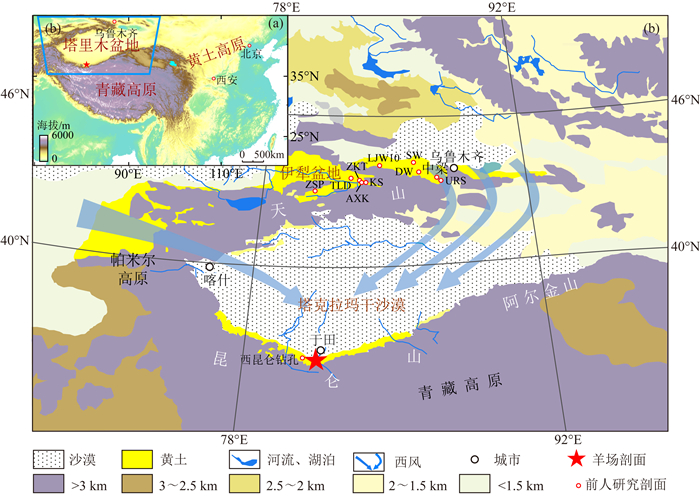
|
图 1 研究区位置(a)及自然地理概况(b) ZSP和TLD剖面引自Song et al., 2010;ZKT和AXK剖面引自Jia et al., 2012;KS剖面引自Jia et al., 2011;LJW10引自Li et al., 2015c;SW引自Li et al., 2015a;DW剖面引自Zan et al., 2012;中梁剖面魏海涛等, 2013;URS剖面引自Lu et al., 2016;西昆仑钻孔引自Zan et al., 2010. Fig. 1 Location (a) and physical geography of study area (b) ZSP and TLD cited from Song et al., 2010; ZKT and AXK cited from Jia et al., 2012; KS cited from Jia et al., 2011; LJW10 cited from Li et al., 2015c; SW cited from Li et al., 2015a; DW cited from Zan et al., 2012; ZL cited from Wei et al., 2013; URS cited from Lu et al., 2016; Kunlun mountains loess drill core cited from Zan et al., 2010. |
为此,本文选取塔里木盆地南缘具有精确年代控制的典型黄土剖面,开展岩石磁学和高分辨率磁化率研究.然后,利用交叉小波分析方法并结合剖面粒度、矿物及元素特征对其磁化率变化机制进行初步探讨,以期为利用磁化率恢复新疆甚至中亚地区全新世以来的古气候变化历史提供新的线索.
1 研究区概况塔里木盆地位于欧亚大陆内部,平均海拔800~1300 m,为天山、阿尔金山和西昆仑山所环绕(图 1).特殊的位置和地形使得太平洋和印度洋水汽很难到达盆地内部,仅有西风能够翻越帕米尔高原和天山(韩永翔等, 2006),将有限的大西洋水汽携带至此,年均降水量小于100 mm,蒸发量大于3000 mm(朱秉启等, 2013).极端干旱的气候孕育了世界上最大的内陆沙漠——塔克拉玛干沙漠,盆地南缘发育有与塔克拉玛干沙漠同源异相沉积的风成黄土.在丰富的近源物质和强大的粉尘搬运动力作用下,于田地区发育了我国内陆干旱区厚度最大的黄土沉积(Fang et al., 2002; Zu et al., 2008).
羊场剖面位于塔里木盆地南缘于田县普鲁村克里雅河支流的五级阶地上,海拔约为2440 m.总厚度为18.1 m,其中顶部0.5 m为现代土壤层,底部为古河道残留的砾石层,其余为砂黄土与弱发育的浅褐色古土壤互层(图 2).剖面年代序列的建立主要基于沉积物的光释光测年以及碳屑和底部火塘中骨头的AMS 14C测年,最终获得的剖面沉积物年代为8.5~0.2 ka(Han et al., 2014, 2019).
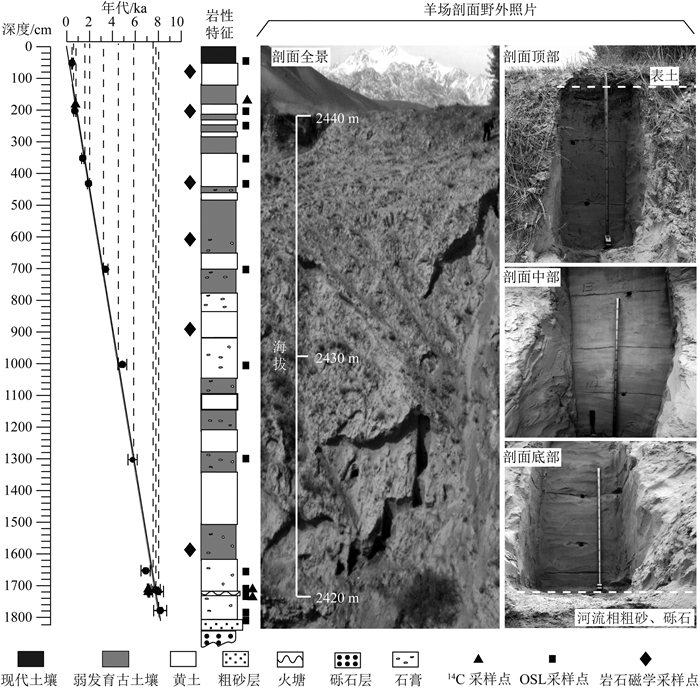
|
图 2 羊场剖面深度-年代关系及野外地层特征(年代引用自Han et al., 2014, 2019) Fig. 2 Depth-age and stratigraphic features of Yangchang section (Age cited from Han et al., 2014, 2019) |
野外以5 cm等间距采集样品362个,全部样品在室内烘干待用.使用捷克AGICO公司生产的MFK1-FA型KappaBridge磁化率仪进行低频和高频磁化率测试,测试频率分别为976 Hz和15616 Hz,为排除仪器稳定性和外界干扰对数据的影响,采用连续多次测量的方法,连续选取三个稳定的测量结果计算求得平均值,经质量归一化后得到低频质量磁化率(即磁化率,χlf)和高频质量磁化率(χhf),并利用公式:χfd=χlf -χhf和χfd%=(χlf-χhf)/χlf×100%分别计算得到频率磁化率(χfd)和频率磁化率百分含量(χfd%).
根据χlf的变化特征选取六个代表性样品(具体深度见图 2)进行岩石磁学分析.磁化率随温度变化曲线(热磁曲线)的测试采用MFK1-FA型KappaBridge磁化率仪,升温和降温辅助工作由CS4高温装置在氩气环境下完成,升温最大值为700 ℃;磁滞回线由VFTB(variable field transition balance)测量完成,并同时获得剩磁(Mrs)、饱和磁化强度(Ms)、矫顽力(Bc)、剩磁矫顽力(Bcr)等磁滞参数.
粒度实验首先去除有机质和碳酸盐,再加入六偏磷酸钠溶液进行充分分散,上述前处理完成后利用Microtrac S3500激光粒度仪进行测试.矿物种类的测定采用荷兰帕纳科公司的X′pert Pro MPD粉末X射线衍射仪,测试条件为Cu靶,扫描步长为0.02°(2θ),工作电压为40 kV,电流为80 mA.选取47个样品进行弱酸溶解和全岩消解,并分别对两种组分进行Fe含量的测试.具体方法如下:称取0.2 g样品至离心管,加入10%的醋酸,充分反应后静置12 h,离心后取上清液得到弱酸溶解组分;称取20~25 mg样品至特氟龙消解瓶中,加入HF和HNO3,将高压消解仪置于190 ℃烘箱加热不少于24 h,定容后得到全岩消解组分.两种组分Fe含量由美国Leeman labs公司生产的电感耦合等离子体发射光谱仪(ICP-OES)测定.
交叉小波分析是将传统小波变换和交叉谱分析相结合的一种信号分析技术,本文使用Morlet小波函数进行小波变换,函数的计算通过MATLAB软件实现,最终得到交叉小波能量谱图.能量谱图的横坐标表示时间,纵坐标表示共振周期,颜色表示相关的显著性,箭头为交叉小波相位角,表示两个序列随时间变化的滞后性,其中右为正相位(相位角0°)、左为负相位(相位角180°).此外,黑色弧形线为小波影响锥的边界,边界内的区域为有效功率谱区,有效功率谱区内被黑色曲线环绕的区域为显著性α=0.05的置信区间.详细计算过程见Jevrejeva等(2003)和Grinsted等(2004).
磁化率、热磁曲线以及元素和粒度的前处理和测试工作在中国科学院青藏高原研究所完成,矿物测试和交叉小波分析工作在中国科学院青海盐湖研究所完成,磁滞回线在德国图宾根大学测试完成.
3 结果与分析 3.1 磁化率与粒度变化羊场剖面χlf平均值约为33.68×10-8 m3·kg-1,以2.5 ka(5.4 m)为界线,其上部(阶段Ⅱ)和下部(阶段Ⅰ)表现出明显的阶段性特征(图 3a).阶段Ⅰ:8.5~2.5 ka(18.1~5.4 m),χlf波动幅度较小,但平均值略高于整个剖面,约为34.0×10-8 m3·kg-1.阶段Ⅱ:2.5~0.2 ka(5.4~0 m),χlf波动幅度较阶段Ⅰ明显增大,且呈现出一定的降低趋势.根据磁化率在阶段Ⅱ的降低幅度,可以进一步将该阶段划分为两个次级阶段:Ⅱ-a(2.5~1.8 ka)为由高磁化率值向低磁化率值的过渡阶段;Ⅱ-b(1.8~0.2 ka)为稳定的磁化率低值阶段,χlf平均值降至29.89×10-8 m3·kg-1.χfd与χfd%数值较低,χfd小于1×10-8 m3·kg-1,χfd%小于3%,二者波动幅度较小,变化趋势也较为一致(图 3b, c),均在8.5~2.5 ka呈缓慢降低趋势,并在2.5 ka以后趋于稳定.
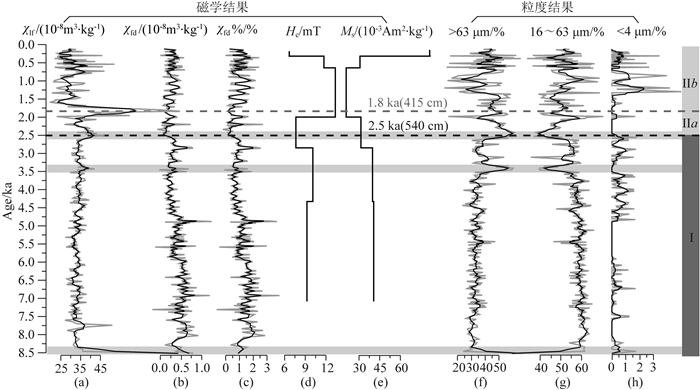
|
图 3 羊场剖面磁学、粒度参数随年代变化特征(>63 μm粒度数据滕晓华等, 2015;粗线为5点平滑曲线) Fig. 3 Magnetic and grain size parameters distributions with the age of Yangchang Section (> 63 μm grain size data cited from Teng et al., 2015; Thick lines are 5-points smoothing curves) |
羊场剖面粒度较粗,以中、粗粉砂和砂为主,粘粒不到3%(图 3f, g, h).其波动幅度也表现出明显的阶段性特征,阶段Ⅰ各粒级组分的波动幅度较小,仅在8.5 ka、3.5 ka和2.5 ka前后出现短暂变粗的过程.阶段Ⅱ各粒级组分的波动幅度均显著增大,且粗颗粒含量较上一阶段整体增多(图 3f).
3.2 磁滞特征磁滞性质是铁磁性物质和亚铁磁性物质的一个重要特征,依据磁滞回线的形态特征和相关磁滞参数,可获取磁性矿物的种类和含量信息(Thompson and Oldfield, 1986).如图 4所示,经过顺磁校正的磁滞回线(实线)形态大体相似,均在200 mT之前快速上升,并在300 mT之前接近形成闭合曲线,线型总体陡直纤细,表明羊场剖面磁性矿物以低矫顽力的软磁性矿物为主.同时,磁滞回线形态在阶段Ⅰ与阶段Ⅱ也表现出一定的差异,阶段Ⅰ样品(600 cm、890 cm、1595 cm)“蜂腰型”特征相对明显,阶段Ⅱ的445 cm和210 cm“腰型”相对宽缓,表明阶段Ⅰ样品所含的软磁性矿物含量相对较高.
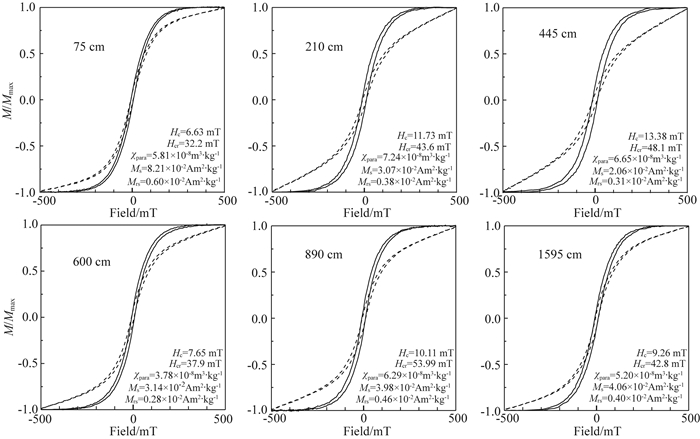
|
图 4 羊场剖面代表性样品磁滞回线特征 虚线表示校正前的磁滞回线. Fig. 4 Hysteresis loops of the representative samples from Yangchang Section The dashed lines are uncorrected. |
从磁滞参数的变化上看(图 3d, e),阶段Ⅱ较阶段Ⅰ剩磁矫顽力(Hc)相对较高,剩余磁化强度(Ms)相对较低,同样也表明阶段Ⅰ样品中软磁性矿物含量相对较高.此外,顺磁校正前的磁滞回线在300 mT后均封闭成为直线,表明存在一定的顺磁性矿物.利用磁滞回线高场强线性段拟合得到的顺磁磁化率(χpara)可以进一步指示顺磁性矿物的相对含量(Dunlop et al., 1998).图 4显示,阶段Ⅱ的χpara整体高于阶段Ⅰ,表明阶段Ⅱ样品可能含有更多的顺磁性矿物.磁滞回线特征及磁滞参数指示阶段Ⅱ相对于阶段Ⅰ含有更多的硬磁性和顺磁性矿物,而软磁性矿物的含量则相对较低.将磁滞特征与磁化率曲线对比后发现,χlf在阶段Ⅱ的突然降低与Hc的升高和Ms的降低具有一致性(图 3a, d, e),可能暗示了磁化率的降低与该阶段软磁性矿物相对减少,而硬磁性和顺磁性矿物相对增多有关.
Day图可以反映磁性矿物的畴态信息(Day et al., 1977).根据磁滞参数比值的不同,磁性矿物畴态可以划分为如下区间:单畴(SD)颗粒MRS/MS>0.5,HCR/HC<1;多畴(MD)颗粒MRS/MS<0.1,HCR/HC>4;假单畴(PSD)颗粒介于两者之间(Thompson and Oldfield, 1986).将羊场剖面各样品的磁滞参数比值投于Day图(图 5),结果显示,样品中磁性矿物颗粒主要集中在MD区域和PSD区域,表明羊场剖面磁性颗粒总体较粗.此外,阶段Ⅱ样品中的磁性矿物较阶段Ⅰ更靠近PSD区域,表明阶段Ⅱ样品具有相对更细的磁性矿物颗粒.
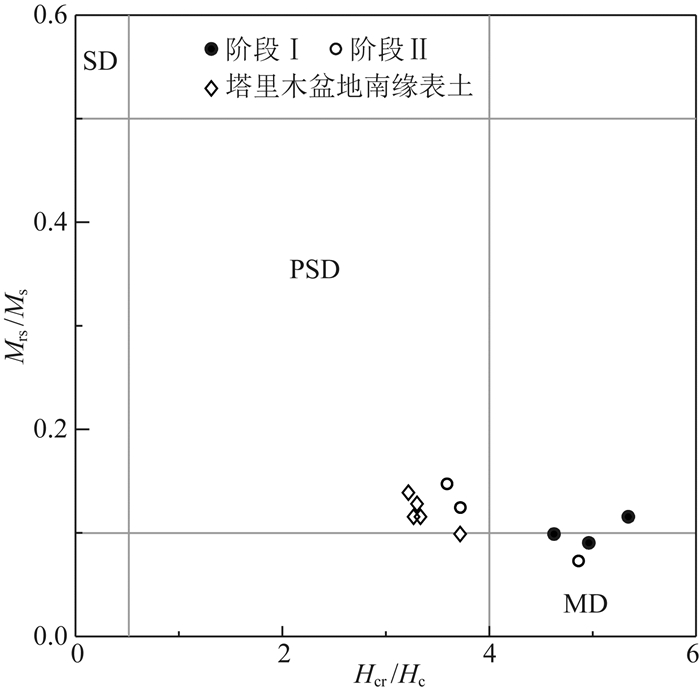
|
图 5 羊场剖面代表性样品及塔里木盆地南缘表土样品Day图(塔里木盆地南缘表土数据引自Zan et al., 2011) Fig. 5 Hysteresis ratios plotted on Day′s Diagram for representative samples from Yangchang Section and surface soils in southern Tarim Basin (Data of surface soils in southern Tarim Basin cited from Zan et al., 2011) |
热磁曲线表征了磁性矿物在加热和冷却过程中的变化,能够较好地揭示磁性矿物的种类(Deng et al., 2000; Liu et al., 2010).如图 6所示,羊场剖面代表性样品的降温曲线均不同程度地高于升温曲线,表明样品中含有能够在受热后转化为强磁性矿物的弱磁性组分;在温度逐渐升至260 ℃的过程中,磁化率缓慢升高,这可能是由于铁的氢氧化物(如针铁矿)逐渐脱水转化为磁赤铁矿所致(Oches and Banerjee, 1996);当温度升至300~450 ℃后磁化率开始下降,这可能是由于磁赤铁矿受热转化为赤铁矿所致;当样品加热到580 ℃左右时,所有样品的磁化率值均大幅度降低,表明羊场剖面的主要载磁矿物为磁铁矿;当温度接近700 ℃时,样品的磁化率值并未达到0,暗示了赤铁矿的存在,但由于加热过程中可能有新的赤铁矿生成,因此热磁曲线无法确定代表性样品中是否含有原生赤铁矿.
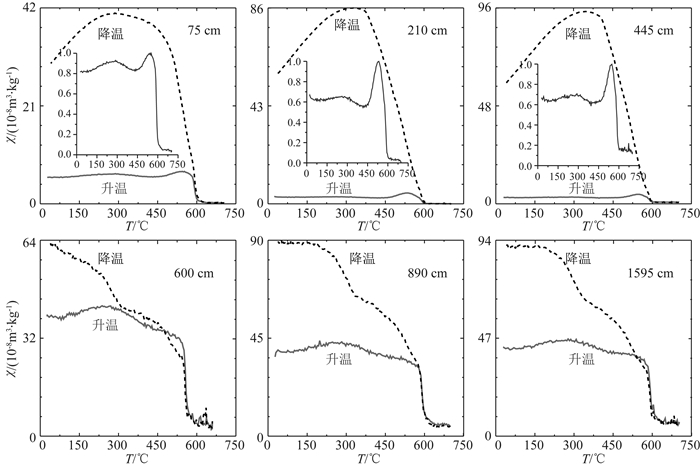
|
图 6 羊场剖面代表性样品的热磁曲线 Fig. 6 Magnetic susceptibility versus temperature curves of the representative samples from Yangchang Section |
热磁曲线形态在阶段Ⅰ和阶段Ⅱ也表现出明显的差异性:阶段Ⅱ代表性样品(75 cm、210 cm、445 cm)的升温曲线经归一化之后在520 ℃处出现一个较大的峰值,与阶段Ⅰ样品形成了鲜明的对比.此外,经历一次升温—降温过程之后,阶段Ⅱ代表性样品磁化率的增大幅度明显高于阶段Ⅰ,呈现近十倍(75 cm)甚至二十倍(210 cm、445 cm)的增幅.这表明阶段Ⅱ样品中存在更为丰富的升温后可转化为强磁性矿物的弱磁性组分,而在升温过程中形成的强磁性矿物很可能是由某种顺磁性矿物转化而来(Thompson and Oldfield, 1986).对于这种可能存在的顺磁性矿物主要有两种解释:1)含铁硅酸盐或粘土矿物在加热过程中分解生成强磁性的磁铁矿(Oldfield, 1991; Hanesch et al., 2010; Liu et al., 2010);2)黄铁矿在加热到380 ℃后开始逐渐转化为磁铁矿或磁黄铁矿(Lambert et al., 1998; Shi et al., 2001; Weaver et al., 2002).为确定这种顺磁性矿物的类型,本文进一步对两个阶段的样品进行矿物组分分析.
3.4 矿物学结果X射线衍射(XRD)结果显示,羊场剖面矿物主要以石英、钠长石和方解石为主,并含有少量的白云石.磁性矿物的衍射峰信号较弱,能够检测到的磁性矿物主要有磁铁矿、磁赤铁矿、富铁绿泥石及黄铁矿.同时,峰高的变化特征显示黄铁矿在阶段Ⅱ的样品中相对更为富集(图 7).但由于黄铁矿信号较弱,难以避免测量过程中存在的背景和噪音的影响,为此,本文利用元素地球化学方法来进一步识别黄铁矿在整个剖面可能的变化情况.
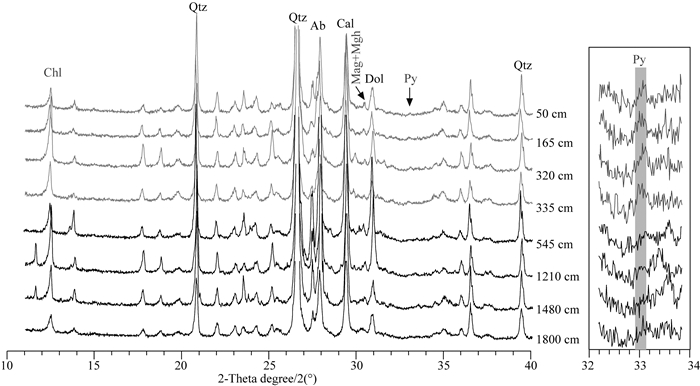
|
图 7 羊场剖面代表性样品XRD谱图 深色线为阶段Ⅰ样品,浅色线为阶段Ⅱ样品,右侧方框内曲线为黄铁矿等比例放大后的谱图;Qtz, 石英;Chl, 绿泥石;Ab, 钠长石;Cal, 方解石;Dol, 白云石;Mag, 磁铁矿;Mgh, 磁赤铁矿;Py, 黄铁矿. Fig. 7 XRD spectrum of the representative samples from Yangchang Section The dark lines are samples in stage Ⅰ, and the light lines are samples in stage Ⅱ. The curves in the frame on the right are the XRD curves after being magnified in equal proportion; Qtz, quartz; Chl, chlorite; Ab, albite; Cal, calcite; Do, dolomite; Mag, magnetite, Mgh, maghemite; Py, pyrite. |
与常见的含铁氧化物和硫化物相比,黄铁矿在非氧化性酸中的溶解能力相对较弱(Hu et al., 2002).根据黄铁矿在溶解性方面的特征,使用非氧化性弱酸(10%的醋酸)对羊场剖面47个代表性样品进行酸溶铁的提取,并通过全岩消解的方法得到每个样品的总铁含量,最后利用总铁对酸溶铁进行校正,以排除本底的影响.因此,校正后的Fe可以间接指示溶解能力相对较弱的含铁磁性矿物的相对丰度,进而对XRD指示的黄铁矿变化结果予以辅助证明.
校正前后的Fe含量变化如图 8所示,酸溶铁以及由总铁校正后的酸溶铁在2.5 ka前后均呈现明显的下降趋势,表明阶段Ⅱ样品较阶段Ⅰ含有更多的难溶于非氧化性酸的含铁矿物,这与XRD方法揭示的黄铁矿在阶段Ⅱ相对增多的特征相一致.此外,弱酸难容相Fe的增多与χlf在2.5 ka后的显著降低具有很好的对应关系,表明这种难溶于弱酸的含铁磁性矿物是一种弱磁性矿物,也同样支持了岩石磁学结果.
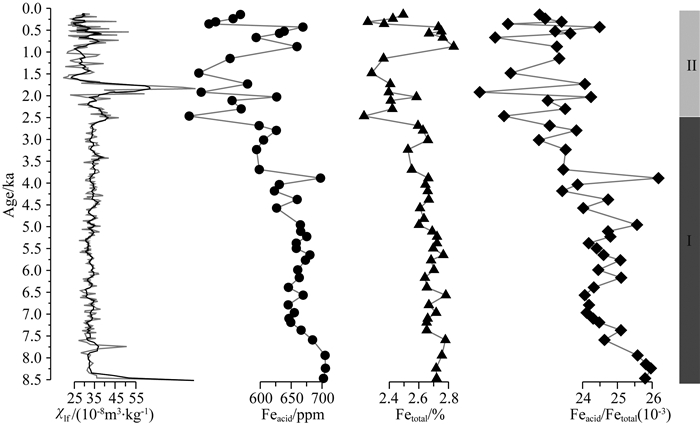
|
图 8 羊场剖面酸溶Fe、总Fe及校正Fe含量变化及其与χlf的对比 Feacid:酸溶铁,Fetotal:总铁,Feacid/Fetotal:由总铁校正后的酸溶铁. Fig. 8 Acid-soluble Fe, total Fe and adjusted Fe with the age of Yangchang Section, and the comparison to χlf Feacid: acid-solved Fe; Fetotal: total Fe; Feacid/Fetotal: acid-solved Fe adjusted by total Fe. |
上述岩石磁学、矿物学以及元素地球化学结果综合表明,羊场剖面的主要载磁矿物为磁铁矿,并含有少量以赤铁矿和针铁矿为代表的硬磁性矿物和以黄铁矿和绿泥石为代表的顺磁性矿物.磁性矿物主要以PSD颗粒和MD颗粒为主(图 5),具有明显的粗颗粒特征,这与同处于塔里木盆地南缘的西昆仑黄土钻孔磁性矿物特征(Zan et al., 2010)一致.同时,阶段Ⅱ样品的磁性矿物颗粒较阶段Ⅰ更细,与塔里木盆地南缘现代表土沉积物的磁性矿物粒径更为接近(图 5).Zan等(2011)对塔里木盆地南缘不同海拔表土岩石磁学特征综合分析发现,研究区现代表土沉积物的磁性特征主要受源区粗颗粒磁性矿物控制,成壤作用形成的SP和SD颗粒组分对其影响微弱.对塔里木盆地内部表土和风成沙的岩石磁学研究也同样发现,该区表层沉积物磁性矿物主要以位于PSD和MD区间的原生粗颗粒磁性矿物组分为主(Torii et al., 2001; Zan et al., 2014).此外,这种受控于源区粗颗粒磁性矿物性质的黄土磁学特征在伊犁盆地和天山北麓的黄土剖面中也广泛存在(Song et al., 2010; Zan et al., 2012; 魏海涛等, 2013; Li et al., 2015b; Lu et al., 2016),表明羊场剖面岩石磁学特征很大程度上继承了塔里木盆地源区的岩石磁学性质,这种受控于源区粗颗粒磁性矿物性质的现象可能是新疆黄土的普遍特征,而与表现为细粒磁性矿物特征的黄土高原地区黄土(Heller and Liu, 1984; Zhou et al., 1990; 邓成龙等, 2007)具有明显的空间差异.
羊场剖面的磁学特征在时间上也具有一定的阶段性,表现为2.5 ka以后磁化率的迅速降低(图 3a)和岩石磁学性质的显著变化(图 4,5,6).结合上述矿物和元素特征综合分析表明,顺磁性黄铁矿和某种硬磁性矿物含量在阶段Ⅱ的相对升高,是导致该阶段磁化率降低和岩石磁学性质变化的主要原因.黄土中出现黄铁矿的报道主要集中于高纬阿拉斯加和西伯利亚地区,认为黄铁矿可能是由亚铁磁性矿物在还原淋滤条件下形成(Liu et al., 1999; 刘秀铭等, 2007a, 2007b),在此过程中,通常还会有褐铁矿、针铁矿等相对喜湿的硬磁性矿物伴随黄铁矿出现(郭雪莲等, 2012; 侯顺民, 2016),这也符合羊场剖面阶段Ⅱ顺磁性矿物和硬磁性矿物同时增多的特征.Zan等(2011)在塔里木盆地南缘高海拔表土中曾发现与阶段Ⅱ样品岩石磁学特征相似的磁性矿物,并推测这种磁性矿物的形成可能是由于高海拔地区具有温度低且有效降水相对较高的环境条件,使地表形成了类似高纬地区的还原环境,这种观点对于羊场剖面黄铁矿的形成具有一定的参考价值.
4.2 塔里木盆地南缘8.5 ka以来的黄土磁化率变化机制初探利用黄土磁化率进行古气候重建研究主要基于对磁化率变化机制的深入理解,目前已被广泛认同的磁化率变化机制主要有“成壤说”、“风速论”和“还原性成壤”机制.“成壤说”强调成壤过程中形成的超顺磁颗粒是导致磁化率升高的主要原因,表现为磁化率在古土壤中相对较高,而在黄土中相对较低(Heller and Liu, 1984; Zhou et al., 1990; Liu et al., 2005),同时,指示磁性矿物中超顺磁颗粒相对含量的频率磁化率和频率磁化率百分比也会与磁化率表现出一定的正相关关系(Zhou et al., 1990; 刘青松和邓成龙, 2009).羊场剖面χlf在黄土-古土壤的沉积旋回中与沉积相未表现出规律性变化(图 2,3),χfd%较低且与χlf无明显正相关关系(图 9c,d).因此,羊场剖面的磁化率变化特征不符合“成壤说”模式.
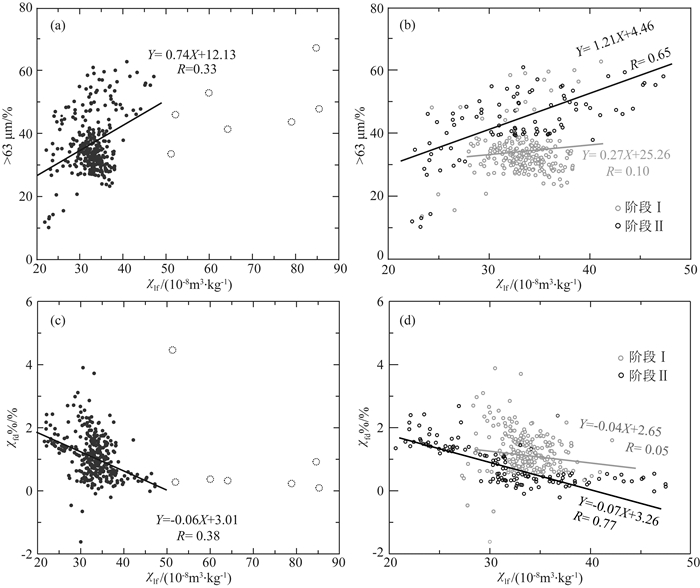
|
图 9 χlf与>63 μm组分及χlf与χfd%在整个剖面(a)(c)及各阶段(b)(d)的相关性 点群之外的数据用虚线圆圈表示,在分析中未予以采纳. Fig. 9 Correlations between χlf and >63μm and χlf and χfd% content of the whole section (a) (c) and each stage (b) (d) Outliers(dashed circles) are removed in correlation analysis. |
“风速论”模式强调原生粗颗粒磁性矿物通量对磁化率的贡献,通常表现为磁化率与粒度的相关性(Zan et al., 2010; Jia et al., 2012; Li et al., 2015a; Lu et al., 2016).羊场剖面磁性矿物主要由PSD和MD颗粒组成(图 5),而PSD颗粒和MD颗粒通常被认为是来自源区的原生组分,很难通过成壤作用形成(Song et al., 2010),因此,羊场剖面磁性矿物性质具有明显的原生粗颗粒特征.此外,羊场剖面的粒度与磁化率也表现出相似的变化特征(图 3a,f),均在阶段Ⅰ小幅稳定波动,而在进入阶段Ⅱ后开始大幅波动.为进一步讨论羊场剖面粗颗粒组分与χlf的关系,我们对χlf与>63 μm组分含量进行相关性分析.结果显示,χlf与>63 μm组分含量在整个剖面具有一定的正相关关系(图 9a),表明羊场剖面χlf整体受到粗颗粒组分的影响,其磁化率变化特征大致符合“风速论”模式.χlf与粗颗粒组分在阶段Ⅰ的相关性相对较弱,这可能与该阶段二者都是小幅稳定波动有关,但从他们同步出现的三次短暂增大过程来看(图 3a, f),二者的变化具有很好的一致性.此外,阶段Ⅰ的磁性矿物相对于阶段Ⅱ更接近于MD区间(图 5),因此,其磁性矿物特征也符合“风速论”模式.
“风速论”模式虽然整体上对羊场剖面磁化率有着明显的影响,但很难解释磁性矿物的次生变化(刘秀铭等, 2007a).羊场剖面阶段Ⅱ磁性矿物特征的变化,表明其磁化率可能还受控于“风速论”模式之外的其他机制.研究表明,在高纬阿拉斯加和西伯利亚地区,相对充足的降水量和较低的蒸发量使得古土壤形成时的环境更接近于还原条件,导致亚铁磁性矿物被还原为弱磁性矿物,如含铁硫化物和针铁矿.此外,这种还原过程还伴随着成壤作用的发生,导致磁化率在古土壤层出现低值,表现出磁化率与成壤作用强度的反相关关系(Liu et al., 1999; 刘秀铭等, 2007a, b; Chen et al., 2016).对于羊场剖面来说,伴随阶段Ⅱ磁化率的明显下降,以黄铁矿为代表的顺磁性矿物和包括可能是针铁矿在内的硬磁性矿物显著增多,暗示阶段Ⅱ磁化率的降低可能与“还原性成壤”机制有关.相关性结果表明,χlf和χfd%在剖面整体表现出一定的负相关(图 9c),特别是在阶段Ⅱ,伴随着磁性矿物的改变,这种负相关性也变得尤为显著(R=0.77),而在阶段Ⅰ则未发现明显的负相关关系(R值仅为0.05)(图 9d).另外,“还原性成壤”机制被认为是冷湿气候条件的产物(Liu et al., 1999; 刘秀铭等, 2007a, b; Chen et al., 2016).前人大量研究发现,塔里木盆地及周边地区2.5 ka前后经历了一次较为显著的气候转型,且以变冷和变湿为主要特征(如: 陈吉阳, 1988; 钟巍等, 1998, 2001; 焦克勤等, 2000; 张成君等, 2007; Zhao et al., 2015; Liu et al., 2016).因此,气候和环境的变化可能为阶段Ⅱ(2.5~0.2 ka)“还原性成壤”机制的发生提供了有利条件.
为进一步证明“还原性成壤”机制对羊场剖面磁化率可能的影响,我们利用交叉小波分析方法对χlf与χfd%做进一步分析.相比于常规的相关性分析,交叉小波分析能够敏感地识别两个时间序列的相关性在时间域和频率域的连续变化特征,如相关性变化的时间节点和细节差异及其共振周期和相位关系(Grinsted et al., 2004).χlf与χfd%的交叉小波分析结果表明(图 10):羊场剖面χlf与χfd%在3 ka之前无相关性.二者的强相关性始于2.5 ka,且在500~700 a共振周期上表现出显著的负相关关系(相位角180°).此外,1.8 ka前后,χlf与χfd%仍表现为强的负相关关系,但二者的共振周期发生明显的转型,从前一阶段的500~700 a周期主导转变为300~400 a和100~200 a两个周期共同主导.交叉小波分析证明了χlf与χfd%自2.5 ka开始的显著负相关性的存在,即在2.5 ka左右,“还原性成壤”机制开始影响羊场剖面磁化率的变化.2.5~1.8 ka共振周期的转型,也很好地对应了磁化率的阶段性变化.综上所述,羊场剖面磁化率在8.5~2.5 ka主要受控于“风速论”模式的影响,2.5 ka以后受到“风速论”和“还原性成壤”两种机制的共同影响.
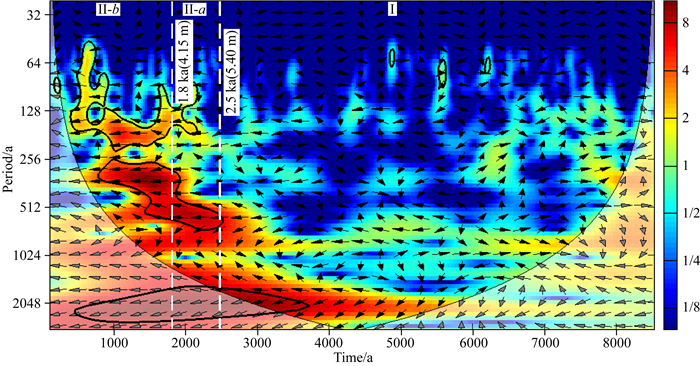
|
图 10 羊场剖面8.5 ka以来χlf与χfd%交叉小波能量谱 Fig. 10 Cross wavelet specteum between the χlf and χfd% from 8.5 ka |
本文基于塔里木盆地南缘有精确年代控制的典型黄土剖面的岩石磁学和高分辨率磁化率研究,结合粒度、矿物以及元素分析结果,主要得出以下结论:
(1) 羊场剖面岩石磁学性质整体受粗颗粒软磁性矿物控制,具体可划分为两个阶段:阶段Ⅰ (8.5~2.5 ka),载磁矿物以亚铁磁性的磁铁矿为主,磁化率值整体较高;阶段Ⅱ(2.5~0.2 ka),亚铁磁性矿物依然占据主导地位,但硬磁性矿物和以黄铁矿为代表的顺磁性矿物相对增多,磁化率值显著降低.
(2) 羊场剖面磁化率与粗颗粒组分整体变化特征相似,并表现出一定的正相关关系,表明羊场剖面磁化率变化总体符合“风速论”模式;2.5 ka以后,伴随磁性矿物性质的变化,羊场剖面磁化率与指示成壤作用的频率磁化率百分含量表现出显著的负相关关系,表明羊场剖面2.5 ka以后的磁化率变化可能还受“还原性成壤”机制的影响.
致谢 两位评审专家和编辑老师提供了宝贵意见,于禄鹏、栗兵帅、杨永鹏、韩文元等参加了野外采样及室内分析工作,宋友桂、张大文、叶程程、申苗苗、李庆宽、张湘如等在论文撰写过程中给予了指导和帮助,在此一并致谢.
An Z S, Kukla G J, Porter S C, et al. 1991. Magneticsusceptibility evidence of monsoon variation on the Loess Plateau of Central China during the last 130, 000 years. Quaternary Research, 36(1): 29-36. DOI:10.1016/0033-5894(91)90015-W |
Begét J E, Hawkins D B. 1989. Influence of orbital parameters on Pleistocene loess deposition in central Alaska. Nature, 337(6203): 151-153. DOI:10.1038/337151a0 |
Begét J E, Stone D B, Hawkins D B. 1990. Paleoclimatic forcing of magnetic susceptibility variations in Alaskan loess during the late Quaternary. Geology, 18(1): 40-43. DOI:10.1130/0091-7613(1990)018<0040:PFOMSV>2.3.CO;2 |
Chen J S, Liu X M, Kravchinsky V A, et al. 2016. Post-depositional forcing of magnetic susceptibility variations at Kurtak section, Siberia. Quaternary International, 418: 2-9. DOI:10.1016/j.quaint.2015.09.092 |
Chen J Y. 1988. The preliminary study of Lichen chronology about the Holocene glacial change in the Urimq River in the Tianshan Mountain. Science in China (Series B) (in Chinese), (1): 95-104. |
Constantin D, Begy R, Vasiliniuc S, et al. 2014. High-resolution OSL dating of the Costineşti section (Dobrogea, SE Romania) using fine and coarse quartz. Quaternary International, 334-335: 20-29. DOI:10.1016/j.quaint.2013.06.016 |
Day R, Fuller M, Schmidt V A. 1977. Hysteresis properties of titanomagnetites:Grain-size and compositional dependence. Physics of the Earth and Planetary Interiors, 13(4): 260-267. DOI:10.1016/0031-9201(77)90108-X |
Deng C L, Zhu R X, Verosub K L, et al. 2000. Paleoclimatic significance of the temperature-dependent susceptibility of Holocene Loess along a NW-SE transect in the Chinese Loess Plateau. Geophysical Research Letters, 27(22): 3715-3718. DOI:10.1029/2000GL008462 |
Deng C L, Liu Q S, Pan Y X, et al. 2007. Environmental magnetism of Chinese loess-paleosol sequences. Quaternary Sciences (in Chinese), 27(2): 193-209. |
Ding Z L, Ranov V, Yang S L, et al. 2002. The loess record in southern Tajikistan and correlation with Chinese loess. Earth and Planetary Science Letters, 200(3-4): 387-400. DOI:10.1016/S0012-821X(02)00637-4 |
Dodonov A E, Sadchikova T A, Sedov S N, et al. 2006a. Multidisciplinary approach for paleoenvironmental reconstruction in loess-paleosol studies of the Darai Kalon section, Southern Tajikistan. Quaternary International, 152-153: 48-58. DOI:10.1016/j.quaint.2005.12.001 |
Dodonov A E, Zhou L P, Markova A K, et al. 2006b. Middle-upper Pleistocene bio-climatic and magnetic records of the Northern Black Sea Coastal Area. Quaternary International, 149(1): 44-54. DOI:10.1016/j.quaint.2005.11.017 |
Dunlop D, Ozdemir O. 1998. Book Review:Rock magnetism:fundamentals and frontiers/Cambridge U Press, 1997. Physics Today, 51(9): 64. DOI:10.1063/1.882466 |
Fang X M, Shi Z T, Yang S L, et al. 2002. Loess sediments in the north piedmont of Tian Shan and its implication for the development of the Guerbantonggute desert. Chinese Science Bulletin, 47(7): 540-545. |
Gao X B, Hao Q Z, Wang L, et al. 2018. The different climatic response of pedogenic hematite and ferrimagnetic minerals:evidence from particle-sized modern soils over the Chinese Loess Plateau. Quaternary Science Reviews, 179: 69-86. DOI:10.1016/j.quascirev.2017.11.011 |
Ghafarpour A, Khormali F, Balsam W, et al. 2016. Climatic interpretation of loess-paleosol sequences at Mobarakabad and Aghband, Northern Iran. Quaternary Research, 86(1): 95-109. DOI:10.1017/S0033589400039740 |
Grinsted A, Moore J C, Jevrejeva S. 2004. Application of the cross wavelet transform and wavelet coherence to geophysical time series. Nonlinear Processes in Geophysics, 11(5/6): 561-566. DOI:10.5194/npg-11-561-2004 |
Guo X L, Liu X M, Guo H, et al. 2012. The magnetic mechanism of S5 paleosol in Baoji section. Quaternary Sciences (in Chinese), 32(4): 785-794. |
Han W X, Yu L P, Lai Z P, et al. 2014. The earliest well-dated archeological site in the hyper-arid Tarim Basin and its implications for prehistoric human migration and climatic change. Quaternary Research, 82(1): 66-72. DOI:10.1016/j.yqres.2014.02.004 |
Han W X, Lü S, Appel E, et al. 2019. Dust storm outbreaks in central Asia after~3.5 kyr BP. Geophysical Research Letters: 46. DOI:10.1029/2018GL081795 |
Han Y X, Yang S L, Fang X M, et al. 2006. Atmospheric circulation in Tarim Basin and loess accumulation in northern slope of Kunlun Mountains. Journal of Desert Research (in Chinese), 26(3): 351-355. |
Hanesch M, Stanjek H, Petersen N. 2010. Thermomagnetic measurements of soil iron minerals:the role of organic carbon. Geophysical Journal of the Royal Astronomical Society, 165(1): 53-61. |
Heller F, Liu T S. 1984. Magnetism of Chinese loess deposits. Geophysical Journal of the Royal Astronomical Society, 77(1): 125-141. DOI:10.1111/j.1365-246X.1984.tb01928.x |
Hou S M. 2016. Magnetic susceptibility change mechanism in Kurtak, Siberia and its paleoclimate Significances[Master's thesis] (in Chinese). Fuzhou: Fujian Normal University.
|
Hu S Y, Deng C L, Appel E, et al. 2002. Environmental magnetic studies of lacustrine sediments. Chinese Science Bulletin, 47(7): 613-616. DOI:10.1360/02tb9141 |
Jevrejeva S, Moore J C, Grinsted A. 2003. Influence of the Arctic oscillation and El Nino-Southern Oscillation (ENSO) on ice conditions in the Baltic Sea:The wavelet approach. Journal of Geophysical Research:Atmospheres, 108(D21): 4677. DOI:10.1029/2003JD003417 |
Jia J, Liu X B, Xia D S, et al. 2011. Magnetic property of loess strata recorded by Kansu profile in Tianshan Mountains. Journal of Arid Land, 3(3): 191-198. DOI:10.3724/SP.J.1227.2011.00191 |
Jia J, Xia D S, Wang B, et al. 2012. Magnetic investigation of late Quaternary loess deposition, Ili area, China. Quaternary International, 250: 84-92. DOI:10.1016/j.quaint.2011.06.018 |
Jiao K Q, Yao T D, Li S J. 2000. Evolution of Glaciers and Environment in the West Kunlun Mountains During the Past 32 ka. Journal of Glaciology and Geocryology (in Chinese), 22(3): 250-256. |
Kukla G, Heller F, Liu X M, et al. 1988. Pleistocene climates in China dated by magnetic susceptibility. Geology, 16(9): 811-814. DOI:10.1130/0091-7613(1988)016<0811:PCICDB>2.3.CO;2 |
Lambert J M Jr, Simkovich G, Walker P L Jr. 1998. The kinetics and mechanism of the pyrite-to-pyrrhotite transformation. Metallurgical and Materials Transactions B, 29(2): 385-396. DOI:10.1007/s11663-998-0115-x |
Li G H, Xia D S, Jia J, et al. 2015a. Magnetic properties derived from a loess section at the northern piedmont of Tianshan Mountains, Xinjiang, China, and their paleoenvironmental significance. Geophysical Journal International, 203(2): 828-839. DOI:10.1093/gji/ggv313 |
Li G H, Xia D S, Jin M, et al. 2015b. Magnetic characteristics of loess-paleosol sequences in Tacheng, northwestern China, and their paleoenvironmental implications. Quaternary International, 372: 87-96. DOI:10.1016/j.quaint.2014.08.002 |
Li G Q, Wen L J, Xia D S, et al. 2015c. Quartz OSL and K-feldspar pIRIR dating of a loess/paleosol sequence from arid central Asia, Tianshan Mountains, NW China. Quaternary Geochronology, 28: 40-53. DOI:10.1016/j.quageo.2015.03.011 |
Liu C L, Zhang J F, Jiao P C, et al. 2016. The Holocene history of Lop Nur and its palaeoclimate implications. Quaternary Science Reviews, 148: 163-175. DOI:10.1016/j.quascirev.2016.07.016 |
Liu T S. 1985. Loess and Environment. Beijing: Science Press: 78-81.
|
Liu Q S, Torrent J, Maher B A, et al. 2005. Quantifying grain size distribution of pedogenic magnetic particles in Chinese loess and its significance for pedogenesis. Journal of Geophysical Research:Solid Earth, 110(B11): B11102. DOI:10.1029/2005JB003726 |
Liu Q S, Deng C L, Torrent J, et al. 2007. Review of recent developments in mineral magnetism of the Chinese loess. Quaternary Science Reviews, 26(3-4): 368-385. DOI:10.1016/j.quascirev.2006.08.004 |
Liu Q S, Deng C L. 2009. Magnetic susceptibility and its environmental significances. Chinese Journal Geophysics (in Chinese), 52(4): 1041-1048. DOI:10.3969/j.issn.0001-5733.2009.04.021 |
Liu Q S, Deng C L, Yu Y, et al. 2010. Temperature dependence of magnetic susceptibility in an argon environment:implications for pedogenesis of Chinese loess/palaeosols. Geophysical Journal of the Royal Astronomical Society, 161(1): 102-112. |
Liu T S, Ding Z L. 2003. Chinese loess and paleomonsoon. Annual Review of Earth and Planetary Sciences, 26(1): 111-145. |
Liu X M, Hesse P, Rolph T, et al. 1999. Properties of magnetic mineralogy of Alaskan loess:evidence for pedogenesis. Quaternary International, 62(1): 93-102. DOI:10.1016/S1040-6182(99)00027-0 |
Liu X M, Liu T S, Xia D S. 2007a. Two pedogenic models for paleoclimatic records of magnetic susceptibility from Chinese and Siberian loess. Science in China (Series D) (in Chinese), 37(10): 1382-1391. |
Liu X M, Xia D S, Liu D S, et al. 2007b. Discussion on two models of paleoclimatic records of magnetic susceptibility of Alaskan and Chinese loess. Quaternary Sciences (in Chinese), 27(2): 210-220. |
Lu H H, Xu Y D, Niu Y, et al. 2016. Late Quaternary loess deposition in the southern Chaiwopu Basin of the northern Chinese Tian Shan foreland and its palaeoclimatic implications. Boreas, 45(2): 304-321. DOI:10.1111/bor.12152 |
Maher B A. 1988. Magnetic properties of some synthetic sub-micron magnetites. Geophysical Journal International, 94(1): 83-96. DOI:10.1111/j.1365-246X.1988.tb03429.x |
Maher B A. 2016. Palaeoclimatic records of the loess/palaeosol sequences of the Chinese Loess Plateau. Quaternary Science Reviews, 154: 23-84. DOI:10.1016/j.quascirev.2016.08.004 |
Oches E A, Banerjee S K. 1996. Rock-magnetic proxies of climate change from loess -paleosol sediments of the Czech Republic. Studia Geophysica et Geodaetica, 40(3): 287-300. DOI:10.1007/BF02300744 |
Oldfield F. 1991. Environmental magnetism-A personal perspective. Quaternary Science Reviews, 10(1): 73-85. DOI:10.1016/0277-3791(91)90031-O |
Peng W B, Nie J S, Wang Z, et al. 2018. A major change in precipitation gradient on the Chinese Loess Plateau at the Pliocene-Quaternary boundary. Journal of Asian Earth Sciences, 155: 134-138. DOI:10.1016/j.jseaes.2017.10.031 |
Shi C D, Zhu R X, Suchy V, et al. 2001. Identification and origins of iron sulfides in Czech Loess. Geophysical Research Letters, 28(20): 3903-3906. DOI:10.1029/2001GL013108 |
Song Y G, Shi Z T, Fang X M, et al. 2010. Loess magnetic properties in the Ili Basin and their correlation with the Chinese Loess Plateau. Science China Earth Science, 53(3): 419-431. DOI:10.1007/s11430-010-0011-5 |
Sun Y B, He L, Liang L J, et al. 2011. Changing color of Chinese loess:Geochemical constraint and paleoclimatic significance. Journal of Asian Earth Sciences, 40(6): 1131-1138. DOI:10.1016/j.jseaes.2010.08.006 |
Teng X H, Zhang Z G, Han W X, et al. 2015. Grain-size characteristics and its environmental significance of loess from southern Tarim Basin. Acta Sedimentologica Sinica (in Chinese), 33(5): 941-950. |
Thomas E K, Clemens S C, Sun Y B, et al. 2016. Heterodynes dominate precipitation isotopes in the East Asian monsoon region, reflecting interaction of multiple climate factors. Earth and Planetary Science Letters, 455: 196-206. DOI:10.1016/j.epsl.2016.09.044 |
Thompson R, Oldfield F. 1986. Environmental Magnetism. London: Allen & Unwin, 758-759.
|
Torii M, Lee T Q, Fukuma K, et al. 2001. Mineral magnetic study of the Taklimakan desert sands and its relevance to the Chinese loess. Geophysical Journal International, 146(2): 416-424. DOI:10.1046/j.0956-540x.2001.01463.x |
Weaver R, Roberts A P, Barker A J. 2002. A late diagenetic (syn-folding) magnetization carried by pyrrhotite:implications for paleomagnetic studies from magnetic iron sulphide-bearing sediments. Earth and Planetary Science Letters, 200(3-4): 371-386. DOI:10.1016/S0012-821X(02)00652-0 |
Wei H T, Banerjee S K, Xia D S, et al. 2013. Magnetic characteristics of loess-paleosol sequences on the north slope of the Tianshan Mountains, northwestern China and their paleoclimatic implications. Chinese Journal of Geophysics (in Chinese), 56(1): 150-158. DOI:10.6038/cjg20130115 |
Zan J B, Fang X M, Yang S L, et al. 2010. A rock magnetic study of loess from the West Kunlun Mountains. Journal of Geophysical Research:Solid Earth, 115(10): B10101. DOI:10.1029/2009JB007184 |
Zan J B, Fang X M, Nie J S, et al. 2011. Magnetic properties of surface soils across the southern Tarim Basin and their relationship with climate and source materials. Chinese Science Bulletin, 56(3): 290-296. DOI:10.1007/s11434-010-4210-4 |
Zan J B, Fang X M, Nie J S, et al. 2012. Rock magnetism in loess from the middle Tian Shan:Implications for paleoenvironmental interpretations of magnetic properties of loess deposits in Central Asia. Geochemistry, Geophysics, Geosystems, 13(10): Q10Z50. DOI:10.1029/2012GC004251 |
Zan J B, Fang X M, Appel E, et al. 2014. New insights into the magnetic variations of aeolian sands in the Tarim Basin and its paleoclimatic implications. Physics of the Earth and Planetary Interiors, 229: 82-87. DOI:10.1016/j.pepi.2014.01.010 |
Zhang C J, Zheng M P, Prokopenko A, et al. 2007. The palaeoenvironmental variation from the high-resolution record of the Holocene sediment carbonate and isotopic composition in Bosten Lake and responding to glacial activity. Acta Geologica Sinica (in Chinese), 81(12): 1658-1671. |
Zhao H, Li S H, Li B, et al. 2015. Holocene climate changes in westerly-dominated areas of central Asia:Evidence from optical dating of two loess sections in Tianshan Mountain, China. Quaternary Geochronology, 30: 188-193. DOI:10.1016/j.quageo.2015.04.002 |
Zhong W, Shu Q, Xiong H G. 2001. Pollen assemblages of Niya section in southern Xinjiang and paleoenvironmental evolution. Geographical Research (in Chinese), 20(1): 91-96. |
Zhong W, Xiong H G, Tashplati T, et al. 1998. The dry wet variation since about 4 ka B. P. revealed by Damugou section located at Cele oasis desert transitional belt. Journal of Desert Research (in Chinese), 18(3): 205-209. |
Zhou L P, Oldfield F, Wintle A G, et al. 1990. Partly pedogenic origin of magnetic variations in Chinese loess. Nature, 346(6286): 737-739. DOI:10.1038/346737a0 |
Zhu B Q, Yu J J, Qin X G, et al. 2013. Formation and evolution of sandy deserts in Xinjiang:the palaeo-environmental evidences. Acta Geographica Sinica (in Chinese), 68(5): 661-679. |
Zu R P, Xue X, Qiang M R, et al. 2008. Characteristics of near-surface wind regimes in the Taklimakan Desert, China. Geomorphology, 96(1-2): 39-47. DOI:10.1016/j.geomorph.2007.07.008 |
陈吉阳. 1988. 天山乌鲁木齐河源全新世冰川变化的地衣年代学等若干问题之初步研究. 中国科学(B辑), (1): 95-104. |
邓成龙, 刘青松, 潘永信, 等. 2007. 中国黄土环境磁学. 第四纪研究, 27(2): 193-209. DOI:10.3321/j.issn:1001-7410.2007.02.005 |
郭雪莲, 刘秀铭, 郭晖, 等. 2012. 宝鸡剖面S5古土壤磁化率变化机制. 第四纪研究, 32(4): 785-794. DOI:10.3969/j.issn.1001-7410.2012.04.24 |
韩永翔, 杨胜利, 方小敏, 等. 2006. 塔里木盆地中的大气环流及昆仑山北坡的黄土堆积. 中国沙漠, 26(3): 351-355. DOI:10.3321/j.issn:1000-694X.2006.03.006 |
侯顺民. 2016.西伯利亚Kurtak剖面磁化率变化机制及其古气候意义[硕士论文].福州: 福建师范大学. http://cdmd.cnki.com.cn/Article/CDMD-10394-1017024588.htm
|
焦克勤, 姚檀栋, 李世杰. 2000. 西昆仑山32 ka来的冰川与环境演变. 冰川冻土, 22(3): 250-256. DOI:10.3969/j.issn.1000-0240.2000.03.010 |
刘东生. 1985. 黄土与环境. 北京: 科学出版社: 78-81.
|
刘青松, 邓成龙. 2009. 磁化率及其环境意义. 地球物理学报, 52(4): 1041-1048. DOI:10.3969/j.issn.0001-5733.2009.04.021 |
刘秀铭, 刘东生, 夏敦胜, 等. 2007a. 中国与西伯利亚黄土磁化率古气候记录-氧化和还原条件下的两种成土模式分析. 中国科学D辑:地球科学, 37(10): 1382-1391. |
刘秀铭, 夏敦胜, 刘东生, 等. 2007b. 中国黄土和阿拉斯加黄土磁化率气候记录的两种模式探讨. 第四纪研究, 27(2): 210-220. |
魏海涛, Banerjee S K, 夏敦胜, 等. 2013. 天山北麓黄土环境磁学特征及其古气候意义. 地球物理学报, 56(1): 150-158. DOI:10.6038/cjg20130115 |
张成君, 郑绵平, Prokopenko A, 等. 2007. 博斯腾湖碳酸盐和同位素组成的全新世古环境演变高分辨记录及与冰川活动的响应. 地质学报, 81(12): 1658-1671. DOI:10.3321/j.issn:0001-5717.2007.12.007 |
钟巍, 熊黑钢, 塔西甫拉提·特依拜, 等. 1998. 策勒绿洲与荒漠交错带达木沟剖面近4ka来干湿波动记录. 中国沙漠, 18(3): 205-209. DOI:10.3321/j.issn:1000-694X.1998.03.003 |
钟巍, 舒强, 熊黑钢. 2001. 塔里木盆地南缘尼雅剖面的孢粉组合与环境. 地理研究, 20(1): 91-96. |
朱秉启, 于静洁, 秦晓光, 等. 2013. 新疆地区沙漠形成与演化的古环境证据. 地理学报, 68(5): 661-679. |
滕晓华, 张志高, 韩文霞, 等. 2015. 塔里木盆地南缘黄土粒度特征及其环境意义. 沉积学报, 33(5): 941-950. |
 2019, Vol. 62
2019, Vol. 62


